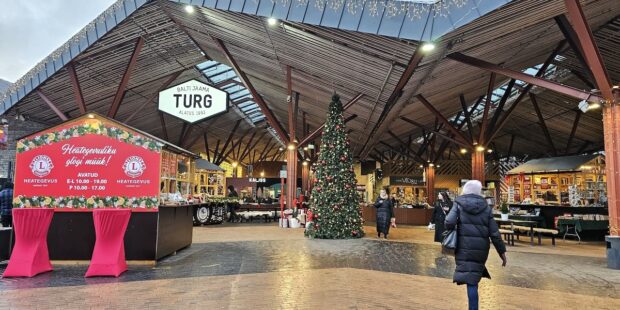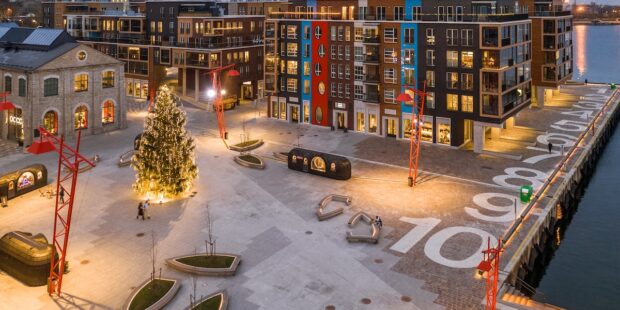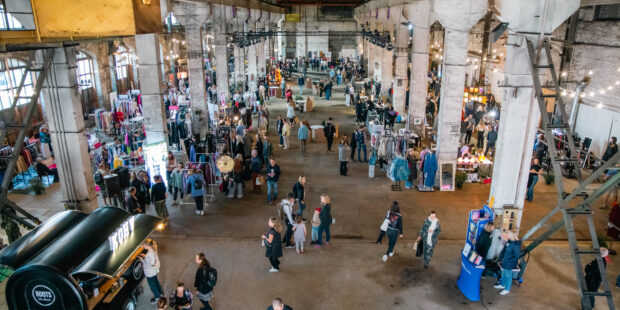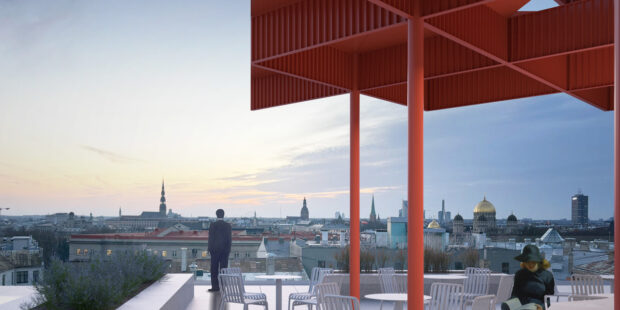In the footsteps of the medieval masters
Text Susanna Poikela Photos Andrei Chertkov, Susanna Poikela, Olde Hansa
 Ceramics artist Kauri Kallas has also worked at the Pentik factory in Posio.
Ceramics artist Kauri Kallas has also worked at the Pentik factory in Posio.
Old traditions are cherished on Laboratooriumi tänav
Laboratooriumi tänav (“street” in English) runs along the northwest wall of Tallin’s old town, it is in this section of the medieval wall that the Labora printing house and calligraphy school is located. Opposite the printing house, in the same courtyard, there is a church. “There is a Ukrainian Greek Catholic church built by my father Anatoly,” explains Nestor Ljutjuk as he opens the door of the main printing house, leading me inside the three-story, maze-like building.
On the first floor, there is a printing press, where books, cards and graphic art are printed using old printing technology from the 15th century. The room is heated by a stove, and next to it, an assistant is currently making cards for Labora’s own art and paper shop on Vene street.
The house’s own paper is made by hand in the basement. The room is filled with the damp, woolly smell of wet paper. At first, the paper looks like felt, but after drying it is soft, flexible and ready for printing. On the top floor of the house, there is a calligraphy studio, where courses are regularly organised.


Ora et Labora et Lege – The secret of a balanced person
“In order for a person to feel well, life should have a spiritual as well as a physical side. So you have to use your hands and head. Such a balance between spirit and matter reflects the true medieval state of mind: Ora et Labora et Lege. Pray, work and read,” says a smiling Nestor. “It has been important for us to preserve old values, lest they disappear forever.”
His latest works can be found in the book “Luontoretkelle Viroon” by writer and journalist Mikko Virta. Nestor Ljutjuk has illustrated all the animal and nature characters in the book. In addition, together with the poet Timo Maran, he has published the beautiful book of poems “Poeetiline punane raamat”. The book takes a stand on the fragile existence of Estonia’s endangered species. “At the moment, the illustration for Timo Maran’s latest book of poems is being completed,” explains Nestor Ljutjuk.

The age-old materials of clay and glass are still fascinating
Latvian glass artist Laura Šmideberga works in the basement of the Parem Pool shop in the masters’ courtyard. Beautiful and colourful glass beads hang from her neck. She takes a Murano glass tube in tongs and starts heating the hard glass under a blue flame. After ten minutes, the tube, which is cold, has been shaped into a translucent and graceful glass ball the size of a small palm. The hands work steadily and the work looks easy, but it is not.
Laura Šmideberga has been working as a glass artist for the past 12 years. She has also collaborated with archaeologists to produce valuable copies based on archaeological finds.
“Glass jewelry was a valid currency in the Middle Ages, and as far as I know, glass beads were not made in Tallinn in the Middle Ages, at least before the 15th century, but were imported from elsewhere. The profession of glass masters was held in high esteem because their material was expensive and only the rich could afford it. Colours were also used in the glassware, and the most popular colour was blue, followed by yellow. Red and pink were rarer because gold was needed to make red glass jewelry,” says Šmideberga.


The studio of ceramic artist Kauri Kallas can be found at the back of the masters’ courtyard. Inside, the clay oven comfortably warms the room. The artist has placed on the table a large clay bust that resembles an African mask. There is another huge and colourful bust on the windowsill which is obviously a finished piece of art.
Kauri’s works are not traditional cups and plates, although of course he also makes them to order. “I haven’t studied medieval art before, but when I was designing the Olde Hansa tableware, I familiarized myself with it and actually got a lot of inspiration for my own works from my observations. In my own works, I deal with the human body. I combine imaginative creatures in my works”, says Kallas.
At the end of last year, the artist curated a joint exhibition of the Association of Ceramic Artists in the Design and Architecture Gallery, which also featured his work “Art of crying”. His piece was a large head that wept. “The theme of the joint exhibition was pressure, and crying relieves pressure,” laughs Kauri Kallas, while gently removing a small lump of clay from the corner of his sculpture’s eye.
Traditional workshops, galleries and art groups in Estonia:
- Parem Pool, Masters’ Courtyard, Vene 6, Tallinn.
- Laura Šmidebergan Glass Studio, Masters’ Courtyard, Vene 6, Tallinn.
- Kauri Kallas, Keraamikakoda, Masters’ Courtyard, Vene 6, Tallinn.
- Labora Shop, Vene 18, Tallinn.
- Labora Printing House, Laboratooriumi 22, Tallinn.
- Tallinna Calligraphy School, Laboratooriumi 22, Tallinn.
- Katariina Guild, Vene 12, Tallinn.
- Carpenter Heikki Põldma, Ridaküla Forge, Suur tee 25, Kolkja.
- Hortus Musicus Medieval Orchestra, Värava torn, Lühike jalg 9, Tallinn.
- Design and Architecture Gallery, Pärnu mnt 6, Tallinn.

Olde Hansa is not a theme restaurant, but a living example of the middle ages
“Do you have relatives from the middle ages,” asks Auri Hakomaa, the owner of the restaurant Olde Hansa. He laughs because the reporter is embarrassed for once. “Well, everyone has them, it hasn’t been long since our ancestors did business here”.
Auri offers the house’s own pepper liquor, which opens the airways and calms the mind. “There are almost twenty of these healthy drinks made with our own recipes on the list.” So there is plenty of choice, and Olde Hansa’s service team will choose the most suitable one for the guest.
Olde Hansa cherishes the medieval heritage down to the smallest detail. Every painting, piece of fabric, costume, plate, glass bowl and bench are handcrafted and art treasures designed by contemporary masters. Live medieval music is also offered six nights a week.
“Countless numbers of talented artists have collaborated with us. All of them have been creating this place. We are not a theme restaurant, but a restaurant that represents real and living culture,” says Hakomaa.
Ceramic artists Rita Randmaa and Kauri Kallas, whose work can also be found in the masters’ courtyard ceramics studio, as well as glass artist Anne-Liis Leht, visual artist Martin Mikson, graphic artist Ari Tenhunen and calligrapher Tatiana Iakovleva have also taken part in the creative process.
“Recently, we ordered textiles typical of the Renaissance from France. This is how Olde Hansa will soon begin to see the effects of the renaissance”, Auri Hakomaa continues, visibly proud of his 25-year-old restaurant.
To learn more about this and similar topicsLabora Laboratooriumi Masters’ Courtyard Medieval Crafts Medieval Glass Medieval Tallinn Old town









